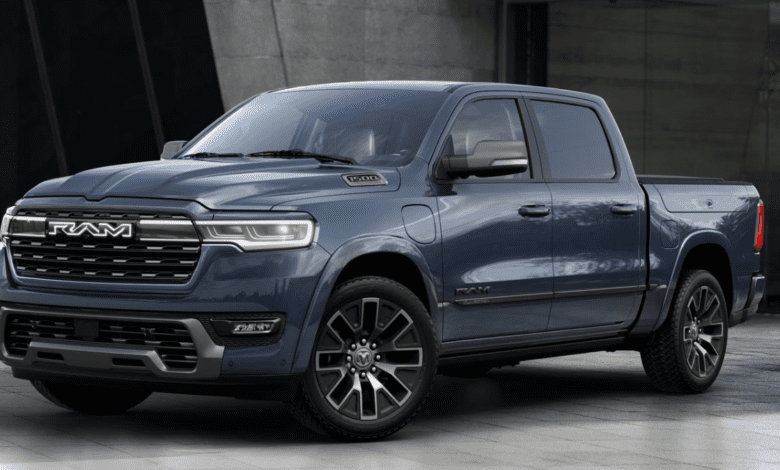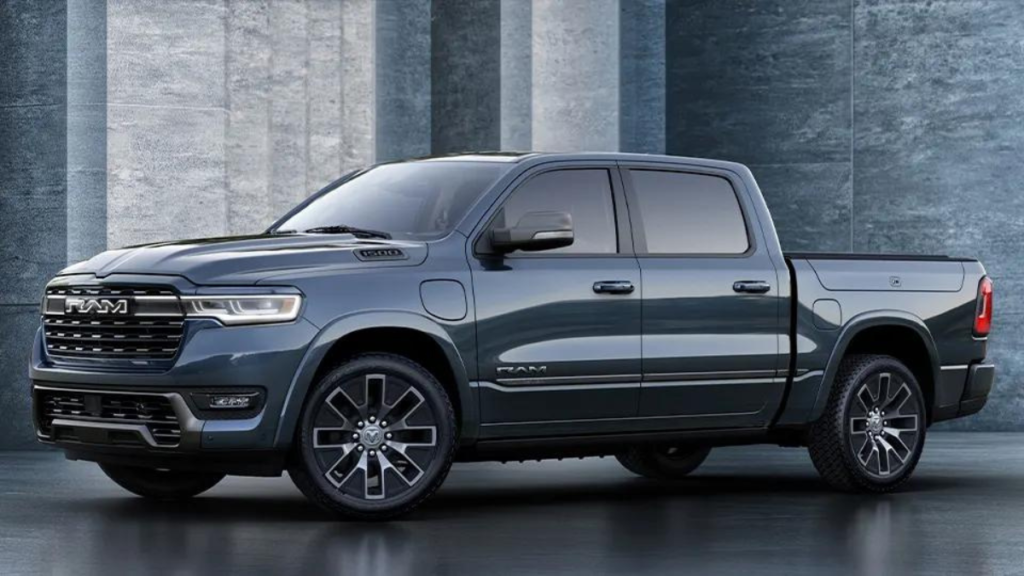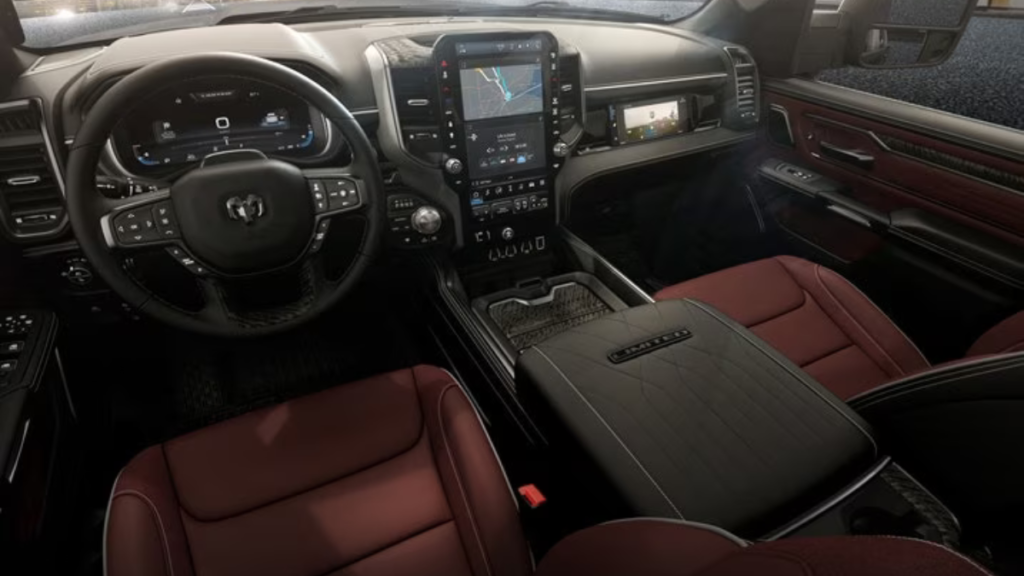Ram 1500 2025 Ramcharger: First Look

Ram 1500 2025 Ramcharger:Looking back, it’s astonishing that no carmaker has yet to imitate the optional range extender offered by the BMW i3. The extender, a modified motorbike engine that provided a gas-powered backup when the battery ran low, was removed by BMW in 2019 in favor of a larger battery. The 2025 Ram 1500 Ramcharger is the return of the idea, enlarged. Like the i3, the Ramcharger is an electric vehicle (EV) equipped with a gas-powered onboard charger—a large V6. Range worry will be eliminated for sure, but pricing anxiety? We’ll see.
The Ramcharger debuted last week at a private event presenting the 2025 Ram 1500 portfolio and is meant to serve as a transitional vehicle between the gas-powered 1500s and the completely electric Ram 1500 REV. The 3.6-liter Pentastar V6 engine that drives the base-model gas-powered 1500 is, in fact, the onboard charger; nonetheless, the truck’s drive architecture is quite similar to that of the REV. It carries a 92 kWh battery pack inside its frame (to the REV’s 168 or optional 229 kWh packs) and powers the wheels with a pair of electric motors.
Stellantis will benefit significantly from the Ramcharger since it hasn’t developed electric pickups as swiftly as Ford and GM have. While it draws inspiration from the i3 and Ford F-150 Lightning, “Nobody else has anything like it,” according to Ram brand CEO Tim Kuniskis, who made this statement during the ceremony last week.
The Hybrid Pickup Series
Over the last 20 years, hybrid vehicles and trucks have become more and more commonplace; nevertheless, series hybrids, also known as Range-Extended Electric Vehicles or REEVs, are uncommon. Only the i3 and a few Nissans sold in Japan have employed this configuration, though the Chevy Volt came close. The onboard combustion engine in a series hybrid is only used to charge the car’s battery and is separate from the drivetrain. While this notion occasionally looked redundant on a little city vehicle like the i3, it’s ideally suited to a pickup truck.
The most energy-intensive usage of any vehicle is towing, which is why heavy trucks need so much energy. When towing at high speeds on a highway, BEVs are least efficient; on city streets, where power consumption is minimal, and braking energy can be recovered, they are most efficient. Until now, the only way to construct electric vehicles with respectable ranges has been to use ever-bigger battery packs. But larger packs bring more weight, expense, and occasionally reduced cargo restrictions (like on the Silverado EV). Even then, they still appear insufficient to some prospective customers.

“Some of our competitors have been dinged from a towing perspective and on towing range, especially as you go out West with longer distances,” said Ramcharger powertrain lead engineer Joe Tolkacz. Such experiences influenced design decisions for the Ramcharger. The gas-powered onboard charger replaces a large portion of the range lost due to towing, allowing for a smaller, lighter, and less expensive battery pack.
Of course, towing an engine and a gasoline tank adds weight, but a 6,000-pound truck can handle the additional weight better than a 3,000-pound vehicle. The Ramcharger offers everything an EV truck lover could want: incredible torque and towing capacity, peaceful operation, acceleration akin to a BMW M3, and even greater truck capability than the gas-powered Ram 1500.
The Ram 1500 Ramcharger’s design
The event featured a bare chassis, which made it simple to understand the Ramcharger’s construction. The battery pack, similar to that of the F-150 Lightning, is tucked into the broader frame rails of the REV to provide it more space and crash protection. The exhaust systems and gasoline tank are the most significant additions. Chief engineer Doug Killian of Ram commented, “That frame architecture is nearly identical fundamentally, only adapted for the generator components.”
The 250 kW front motor directly supports the front axle of the electric motor, while the 238 kW rear motor is somewhat offset. They produced 663 horsepower and 615 pound-feet of torque when combined. Consequently, the vehicle has a 2,650-pound payload capacity, can tow up to 14,000 pounds, and can reach 60 mph in only 4.4 seconds. Compared to the gas-powered Ram 1500, that is about 2,400 pounds greater towing capability and 300 pounds more payload. As only an electric vehicle can, Killian said, “And it’s quiet about its business.”
Although none of Ram’s engineers addressed the possible noise produced by the gas engine, they provided details on how it differs from the standard Ram engine and what it would be like to live with. It has fewer pieces to begin with. It will be lighter because, according to Tolkacz, “we didn’t need the starter, EGR [exhaust gas recirculation] systems, or parts like transmission covers.” Because it is designed to be a stationary engine, it has maintenance modes and oil life quality sensors to ensure its continued good health.
Regarding modes, there exist several options to oversee and maximize energy use. When using Electric Plus, the battery runs the whole system until it has 145 miles left in its range. The onboard generator will then start up. Other modes let you use the gas engine seldom while the car maximizes the range of its accessories (Eco) or saves electric range for later (E-Save). Although Ram did not provide a mileage estimate for fully electric vehicles, the vehicle can go 690 miles before running out of petrol and batteries.
The battery can be quickly charged, but the gas engine also functions as a 130 kW charger. With a 150 kW DC fast charger, the truck’s 400-volt design can add 50 miles of additional charge in 10 minutes. It can also manage charging rates of up to 145 kW.
In addition, there are a lot of models with dynamic drives comparable to the gas-powered ones for off-road, snow, and towing. The Ramcharger will have an off-road air suspension with adjustable ground clearance, extra underbody protection, and skid plates, precisely like the gas 1500. Tolkacz said, “We have to safeguard that battery in any case, but there will be an additional level.”

Technology and Appearance
The Ramcharger visually blurs the boundary between the new-for-2025 Ram 1500 Tungsten premium edition and the REV. “It takes the best, most contemporary elements of the Tungsten and the REV,” said Jeff Aneiros, Ram’s lead external designer. He said that all Ramchargers would be “fascia trucks,” which have an integrated front bumper similar to that of a vehicle rather than the large, separate bumper seen on the majority of Ram 1500s. This also applies to the entry-level Tradesman vehicles, essentially work trucks, which is surprising. New Ram lighting signatures and a modified “RAM” emblem shared with the REV are given to each.
All the technological upgrades seen in gas-powered 1500s are included in the Ramcharger’s interior, along with some particular pages and displays for tracking energy use and steering-wheel-mounted buttons for regenerative braking controls. The new Tungsten finish, which will also be available on the Ramcharger, is the focal point of the interior design for the 2025 Ram 1500.
Additionally, the Ramcharger’s battery turns it into “a power station on wheels,” in Killian’s words. An in-bed power panel with a maximum power output of 7.2 kW is more than sufficient to power a variety of camping gear and construction site instruments. While it is much more than Ford’s factory-installed 2.4 kW supply, it is not as much as the 9.6 kW optional unit for the F-150 Lightning.
Several electronic and active safety systems exist, much like in the 2025 Rams with combustion engines. The most recent version of Stellantis’ Uconnect 5 software will be installed, and they will come with a 12.0-inch infotainment screen as a standard and a 14.5-inch device as an option. Along with a 10.3-inch passenger-side entertainment screen and an optional head-up display, the 12.3-inch digital gauge cluster will come in various layouts and displays, some exclusive to the Ramcharger.
There will be three options for driver assistance: hands-free driving aid, a Level 2 semi-autonomous system, and active driving assist. The latter provides limited hands-free operating on authorized routes comparable to GM’s Super Cruise and Ford’s BlueCruise. A driver monitoring system is also planned. However, whether additional active safety measures are offered as standard vs standard is unclear.
Ramcharger 2025 Dodge Ram 1500: When and How Much?
The Ramcharger is expected to launch with the Ram 1500 REV in the fourth quarter of 2024, while the exact price is yet unknown.
Although Ram’s executives and designers only unveiled the Ramcharger Limited at the occasion, they subsequently confirmed that the truck would be offered in the new Tungsten level and the well-known Tradesman, Bighorn, Laramie, and Limited models. While Tolckacz was quick to note that the Ramcharger would have the same degree of off-roading capabilities as the four-wheel drive combustion-engine Rams, this noticeably leaves out some of the off-road and sport-themed versions, such as the Rebel.
CEO Kuniskis said that the cost and size of an electric vehicle’s battery pack determines its price, but he refused to provide a price range. The Ramcharger’s price may be expected to rise significantly over that of combustion-engine vehicles. Still, considering all of the technology that goes into it, it may lie between the pure-gas variants and the REV.
As with fully electric trucks, exorbitant costs may still be a problem. However, purchasers also receive a vehicle that eliminates concerns about range and charge periods and may satisfy their needs now rather than in ten years. Kuniskis said, “This will be a game-changer for battery electric trucks.”

questions and answers
- Q1: What is unique about the 2025 Ram 1500 Ramcharger compared to other electric vehicles? A1: The 2025 Ram 1500 Ramcharger stands out for its gas-powered onboard charger and large V6 engine, which acts as a range extender. This feature, inspired by the BMW i3, eliminates range anxiety associated with electric vehicles (EVs).
- Q2: How does the Ramcharger’s design cater to towing and energy efficiency? A2: The Ramcharger features a 3.6-liter Pentastar V6 engine as its onboard charger and carries a 92 kWh battery pack. This design allows for a smaller, lighter, and less expensive battery pack, compensating for the range loss due to towing. It is particularly energy-efficient in city driving, where braking energy can be recovered.
- Q3: What is the significance of the Ramcharger in Stellantis’ product lineup? A3: The Ramcharger is significant for Stellantis as it fills a gap in their electric pickup offerings, especially compared to competitors like Ford and GM. It’s a transitional vehicle between the gas-powered Ram 1500s and the fully electric Ram 1500 REV.
- Q4: What are the key features of the Ramcharger’s powertrain and performance? A4: The Ramcharger has a pair of electric motors producing a combined 663 horsepower and 615 pound-feet of torque. It can tow up to 14,000 pounds, carry a 2,650-pound payload, and accelerate to 60 mph in 4.4 seconds.
- Q5: How does the Ramcharger integrate its hybrid system into its design? A5: The Ramcharger’s design incorporates a battery pack within the frame for space and crash protection, with additions like exhaust systems and a gas tank. Its electric motors are strategically placed to support the front axle and provide optimal power distribution.
- Q6: What are some of the technological and aesthetic features of the Ramcharger? A6: The Ramcharger includes advanced technology like a 12.0-inch standard infotainment screen, an optional 14.5-inch screen, various electronic and active safety systems, and a modern exterior design blending elements from the Tungsten and REV models.
- Q7: When is the Ramcharger expected to launch, and how is it priced? A7: The Ramcharger is expected to launch in the fourth quarter of 2024. While the exact price is not disclosed, it is anticipated to be higher than combustion-engine vehicles but with more technological features, striking a balance between pure-gas variants and the REV.




